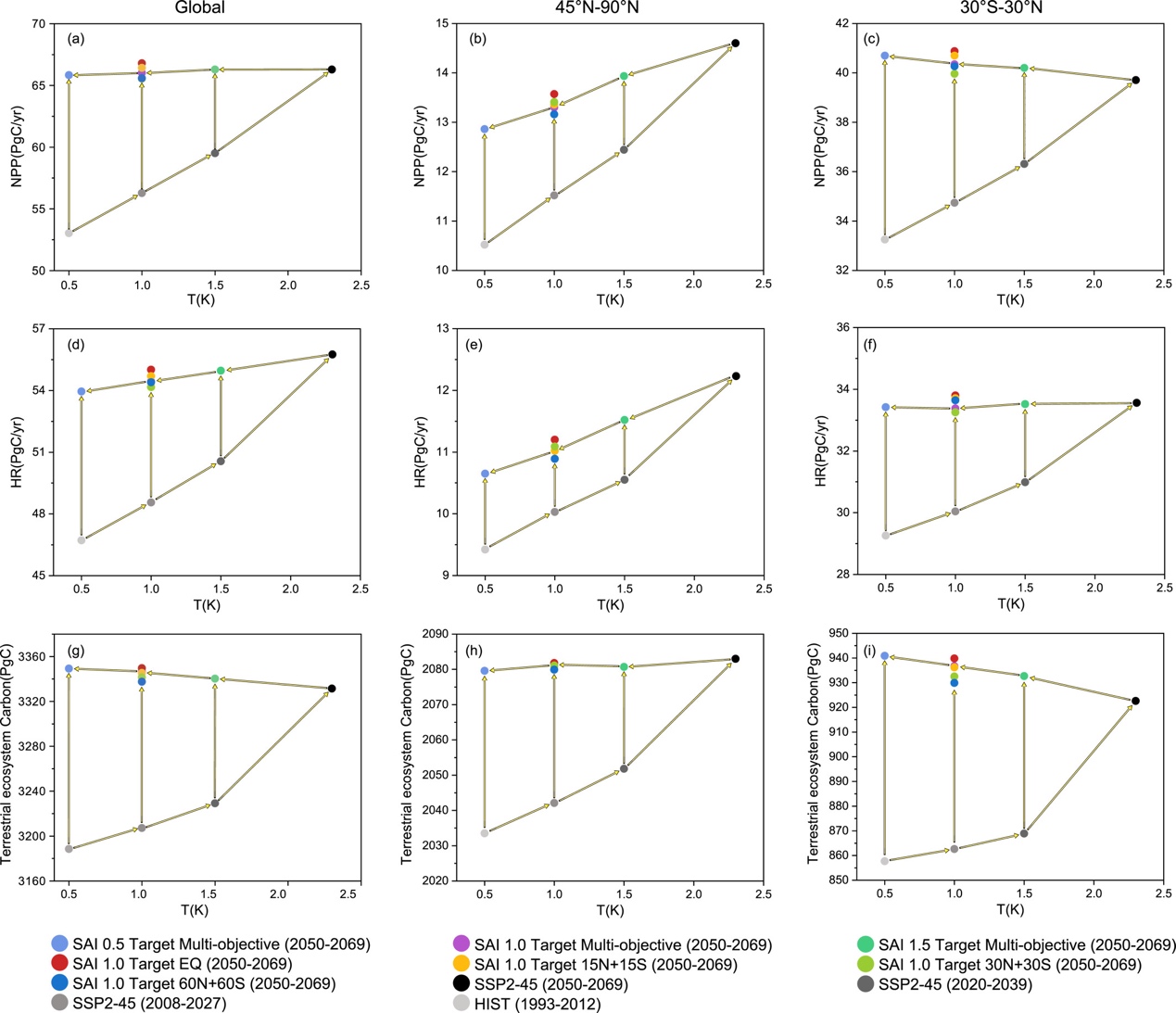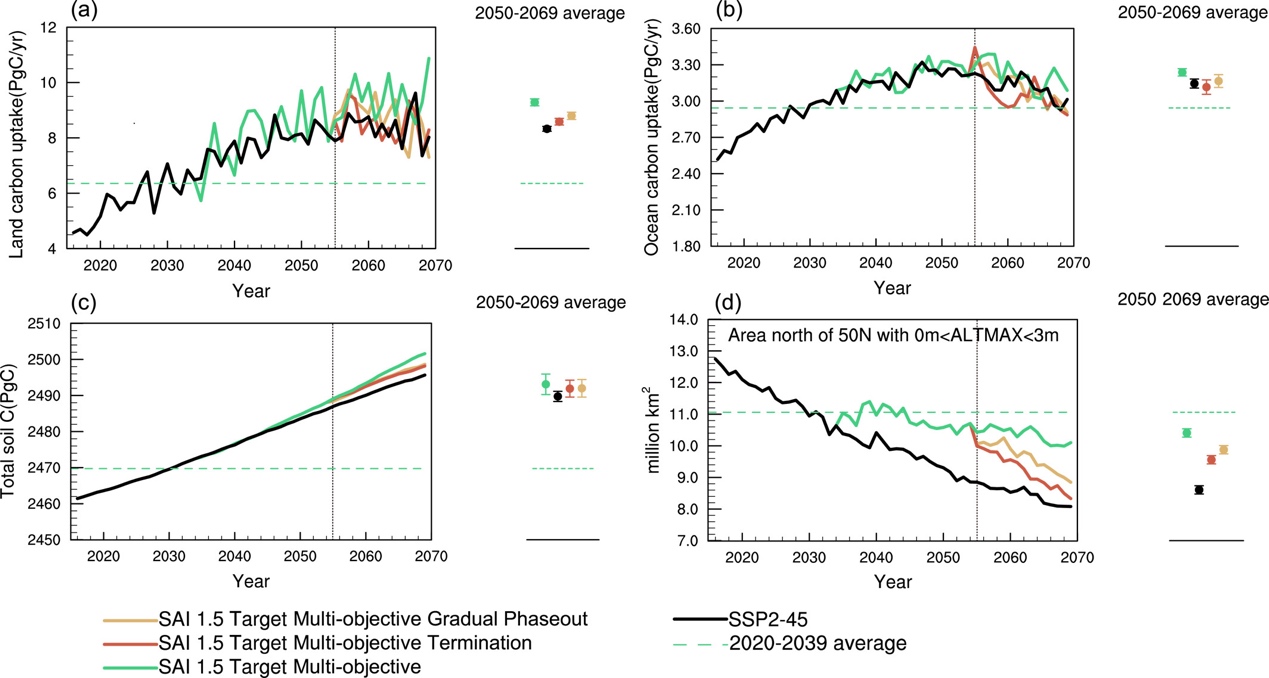Editor: 谢佳 Author: Time: 2024-06-01 Number of visits :161
Stratospheric aerosol injections (SAI) are proposed as a possible additional tool to help counteract global warming. This method would affect aspects of the climate system such as temperature, precipitation, and ocean circulation, which would in turn alter the global carbon cycle. In this study, we examine the carbon cycle response to SAI simulations, to explore how the carbon cycle response depends both on how much cooling is being done by SAI, and on how that cooling is being done.
We use an Earth system model to examine how SAI would affect the ability of land and ocean to absorb CO2. Under a moderate CO2 concentration increase scenario (SSP2-4.5), SO2 is injected into the stratosphere to maintain global temperature at the level of 0.5, 1.0 and 1.5°C above pre-industrial, respectively. Compared to the background scenario, SO2 injections increase the land and ocean CO2 sinks and reduce atmospheric CO2 (diagnosed here as 3%–6% increase in cumulative CO2 emissions that would lead to specific CO2 concentration).

Figure 1. Model-simulated time series of annual mean (a) land carbon uptake, (b) ocean carbon uptake, and (c) diagnosed cumulative CO2 emission. The dashed lines represent the 20-year average values for the baseline period of 1993–2012, 2008–2027 and 2020–2039, corresponding to global mean warming of 0.5°C, 1.0°C, and 1.5°C. The dots on the right panels represent the 20-year average over 2050–2069 and uncertainties are estimated by one standard error.
In addition, SO2 is injected into the stratosphere to meet the 1.0°C temperature target but considers a range of different SO2 injection strategies. For the same 1°C target, the location of SO2 injections (low-latitudes, high-latitudes, multi-latitudes) could produce a range of response in land and ocean CO2 sinks that is as large as that caused by different cooling targets.

Figure 2. Model-simulated terrestrial carbon fluxes (net primary production, NPP; heterotrophic respiration and stocks (terrestrial ecosystem carbon) at different levels of global mean warming. For simulations under SSP2-45 without stratospheric aerosol injection (SAI), what is shown are values averaged over years 1993–2012, 2008–2027, 2020–2039, and 2050–2069 when global warming reaches 0.5°C, 1.0°C, 1.5°C, and 2.3°C relative to pre-industrial level. For simulations with different SAI strategies, what is shown are values averaged over years 2050–2069 for temperature stabilization targets of 0.5°C, 1.0°C, and 1.5°C. For each variable, the left column shows global values, the middle column shows values for Northern Hemisphere mid-to-high latitude (45°N–90°N), and the right column shows values for low latitude (30°S–30°N).
In this study, we also examine the consequences of SAI termination. An abrupt termination of SO2 injection weakens both the ocean and land carbon sink, and causes a rapid decline of permafrost extent. A gradual phaseout of SO2 injection slows sharp decline of permafrost and delays the rebound of carbon sink.

Figure 3. Model-simulated time series of annual mean (a) land carbon uptake, (b) ocean carbon uptake, (c) total soil carbon stocks, and (d) the permafrost extent of the area north of 50°N. The green dashed lines represent the 20-year average values for the baseline period of 2020–2039, corresponding to global mean warming of 1.5°C. The black dashed lines represent the year (2055) that stratospheric aerosol injection is terminated abruptly or gradually. The dots on the right panels represent the 20-year average over 2050–2069 and uncertainties are estimated by one standard error.
SO2 injections slow permafrost thaw but do not entirely restore permafrost to past extents at the same warming level.

Figure 4. Model-simulated permafrost extent north of 50°N at different levels of changes in global mean temperature. For simulations under SSP2-45 without stratospheric aerosol injection (SAI), what is shown are values averaged over years 1993–2012, 2008–2027, 2020–2039, and 2050–2069 when global warming reaches 0.5°C, 1.0°C, 1.5°C, and 2.3°C relative to pre-industrial level. (b) Model-simulated changes in annual maximum active layer thickness (ALTMAX) for SAI 1.0 Target Multi-objective, SAI 1.0 Target EQ, SAI 1.0 Target 60N + 60S and SSP2-4.5 averaged over 2050–2069 relative to SPP2-4.5 averaged over 2008–2027. The black line on the maps indicates permafrost extent averaged over 2008–2027 under SSP2-4.5, and the green line on the maps indicates permafrost extent averaged over 2050–2069 for SAI and SSP2-4.5 simulations.
The first author is Mengying Zhao, who just passed the doctoral thesis defense at the School of Earth Sciences, Zhejiang University. Other authors include Prof. Long Cao at the School of Earth Sciences, Zhejiang University, Prof. Daniele Visioni at the Earth and Atmospheric Sciences, Cornell University and Prof. Douglas G. MacMartin at the Sibley School of Mechanical and Aerospace Engineering, Cornell University.
For details: Zhao, M., Cao, L., Visioni, D., & MacMartin, D. G. (2024). Carbon cycle response to stratospheric aerosol injection with multiple temperature stabilization targets and strategies. Earth's Future, 12, e2024EF004474. https://doi.org/10.1029/2024EF004474
